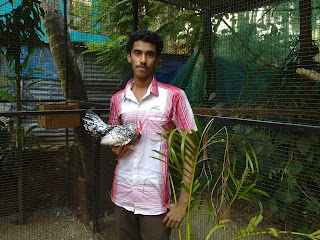Diamond Dove
The Diamond Dove (Geopelia cuneata) is a bird resident in Australia.
They are small pigeons with a length of 19 to 21 centimetres. Regardless of the gender, they have white spots and black edges on their wings, orange eyes and red eye-rings. The genders look similar except the female's eye ring is less vivid and has more of a brown colour to the plumage. The male's head, neck, and breast are light blue-grey. The bill is a dark grey colour. The abdomen is a creamy colour while the back and tail is a brown-grey colour. The legs and feet are pink. The juveniles have a light grey bill; the iris and eye ring is fawn in colour; the feet and legs are grey; the breast is grey and they do not possess any white spots on their wings.
Behaviour
The Diamond Dove can often be seen on the ground with a toddling run. Their flight is strong and direct and can be undulating. The wings can make a whistling "frrr" noise when flying.
Diamond doves tend to be seen in pairs or small groups feeding off the ground. They feed off seed mostly from grasses. They will also eat ants.
The doves tend to breed after rain but mostly in spring in Southern Australia. nests are usually built from interwoven grasses and/or twig. They are of fragile construction. Two white eggs are usually laid and incubated for 13 to 14 days. Chicks are usually fully feathered and flying by two weeks.
They are known to have a variety of calls. The calls sound mournful, slow and have a falsetto quality to them. Two calls consist of two long coos followed by a pause and then a long, short and long coo. Sometimes they call two long coos. The alarm coo consists of a few short but loud coos.






















































